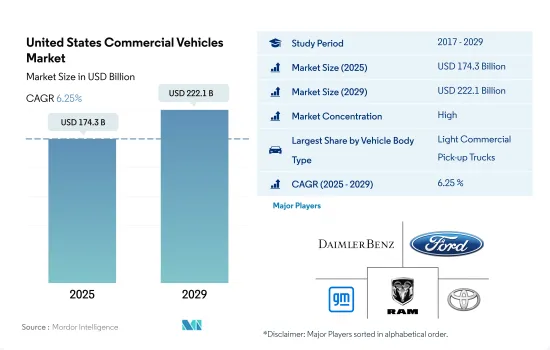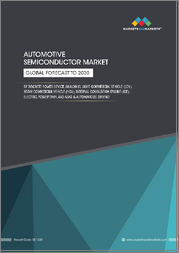
|
시장보고서
상품코드
1693617
미국의 상용차 시장 : 점유율 분석, 산업 동향 및 통계, 성장 예측(2025-2030년)United States Commercial Vehicles - Market Share Analysis, Industry Trends & Statistics, Growth Forecasts (2025 - 2030) |
||||||
미국의 상용차 시장 규모는 2025년 1,743억 달러로 추정되며, 2029년에는 2,221억 달러에 이를 것으로 예측되며, 예측 기간 중(2025-2029년) CAGR 6.25%로 성장할 것으로 예측됩니다.

미국 상용차의 다양성은 견조한 경제로 견인되어 도시 지역의 배달 밴에서 장거리 트럭에 이르기까지 광범위한 수요가 있습니다.
- 상용차 시장은 화물 수송량 증가, 지역 가치 체인의 세계화, 구동 기술의 진보, 안전성에 대한 관심 증가 등의 요인에 의해 끊임없는 진화를 이루고 있습니다. 2005년 이후 연료 가격은 꾸준히 상승하고 있으며 디젤 트럭의 성장에 영향을 미쳤습니다. 게다가 미국 연료 제조업체는 거의 최대한의 생산 능력으로 운영하고 있으며 생산 확대의 여지가 거의 없습니다.
- 유행의 발생은 상용차 산업공급망에 전례없는 혼란을 가져왔습니다. 전 세계적으로 적용된 락다운 및 기타 제한으로 인해 전례없는 규모의 이동 및 이동 제한이 발생했습니다. 인프라와 물류 등 운송에 크게 의존하는 산업은 막히고 제조업과 화물 부문에 새로운 장애를 가져왔습니다.
- 전기자동차와 하이브리드 자동차 수요가 급증하는 가운데, 일부 국가는 전기자동차 충전 인프라의 정비를 우선해 왔습니다. 그 결과, 인프라의 성장을 가속하기 위해 수많은 정책이나 인센티브가 도입되었습니다.
미국 상용차 시장 동향
미국 정부의 이니셔티브와 수요 증가가 견인하는 전기자동차 판매의 급성장
- 미국에서는 최근 전기차(EV)의 도입이 급증하고 있습니다. 2016년, 캘리포니아 주는 이산화탄소 배출량 억제와 대기 환경 개선을 목적으로 한 ZEV 프로그램을 도입했습니다. 이 대처는 캘리포니아 주에서의 전기자동차의 보급에 박차를 가했을 뿐만 아니라, 다른 주에도 비슷한 ZEV 규제를 도입하도록 영향을 주었습니다.
- 미국의 전기상용차 수요도 증가 추세에 있습니다. E-Commerce 산업의 활황, 물류 활동 증가, 보다 클린 수송을 요구하는 정부의 대처 등의 요인이, 이 성장을 뒷받침하고 있습니다. 중요한 활동으로, 뉴욕 주지사가 2021년 9월 첨단 클린 트럭(ACT) 규칙에 서명했습니다. 이 규칙에서는 2035년까지 모든 신형 소형차를 제로 배출화해, 2045년까지 중형차와 대형차도 제로 배출화 하는 목표가 설정되어 있습니다. 그 결과, 미국에서는 2022년에 전기 상용차 수요가 전년 대비 21% 급증했습니다.
- 리베이트, 보조금, 전략적 계획 등 정부의 이니셔티브이 전국적인 자동차의 전동화를 더욱 뒷받침하고 있습니다. 2022년 5월, 바이든 대통령은 가스 자동차에서 전기자동차로 이행을 목표로, 국내에서 배터리 제조를 촉진하는 30억 달러의 계획을 발표했습니다. 이 추진에 의해 특히 2024-2030년간, 국내에서의 전동 모빌리티가 대폭적으로 촉진되어, 그것에 의해 배터리 팩 수요가 증대할 것으로 예상됩니다.
미국 상용차 산업 개요
미국의 상용차 시장은 상당히 통합되어 있으며 상위 5개사에서 80.10%를 차지하고 있습니다. 시장 주요 기업은 Daimler AG(Mercedes-Benz AG), Ford Motor Company, General Motors Company, Ram Trucking, Inc., Toyota Motor Corporation입니다(알파벳순).
기타 혜택
- 엑셀 형식 시장 예측(ME) 시트
- 3개월의 애널리스트 서포트
목차
제1장 주요 요약과 주요 조사 결과
제2장 보고서 제안
제3장 소개
- 조사의 전제조건과 시장 정의
- 조사 범위
- 조사 방법
제4장 주요 산업 동향
- 인구
- 1인당 GDP
- 자동차 구매를 위한 소비자 지출(cvp)
- 인플레이션율
- 자동차 대출 금리
- 전화의 영향
- EV 충전소
- 배터리 팩 가격
- Xev 신모델 발표
- 물류성능지수
- 연료 가격
- OEM 생산 통계
- 규제 프레임워크
- 밸류체인과 유통채널 분석
제5장 시장 세분화
- 차량 유형
- 상용차
- 버스
- 대형 상용 트럭
- 소형 상용 픽업 트럭
- 소형 상용 밴
- 중형 상용 트럭
- 상용차
- 추진 유형
- 하이브리드 및 전기자동차
- 연료 카테고리별
- BEV
- FCEV
- HEV
- PHEV
- ICE
- 연료 카테고리별
- 천연가스
- 디젤
- 가솔린
- LPG
- 하이브리드 및 전기자동차
제6장 경쟁 구도
- 주요 전략 동향
- 시장 점유율 분석
- 기업 상황
- 기업 프로파일
- Daimler AG(Mercedes-Benz AG)
- Daimler Truck Holding AG
- Ford Motor Company
- General Motors Company
- Hino Motors Ltd.
- Isuzu Motors Limited
- PACCAR Inc.
- Ram Trucking, Inc.
- Toyota Motor Corporation
- Volvo Group
제7장 CEO에 대한 주요 전략적 질문
제8장 부록
- 세계 개요
- 개요
- Porter's Five Forces 분석 프레임워크
- 세계의 밸류체인 분석
- 시장 역학(DROs)
- 정보원과 참고문헌
- 도표 일람
- 주요 인사이트
- 데이터 팩
- 용어집
The United States Commercial Vehicles Market size is estimated at 174.3 billion USD in 2025, and is expected to reach 222.1 billion USD by 2029, growing at a CAGR of 6.25% during the forecast period (2025-2029).

The diversity of commercial vehicles in the United States is driven by a robust economy, with demands ranging from urban delivery vans to long-haul trucks
- The commercial vehicle market is undergoing constant evolution due to factors like increased traffic in goods, globalization of regional value chains, advancements in drive technology, and a heightened focus on safety. Since 2005, fuel prices have been on a steady rise, impacting the growth of diesel trucks. Additionally, fuel producers in the United States are operating at near-maximum capacity, leaving little room for production expansion.
- The onset of the pandemic led to unprecedented disruptions in the commercial vehicle industry's supply chains. Lockdowns and other restrictions imposed globally resulted in mobility and travel limitations of an unprecedented scale. Industries heavily reliant on transportation, such as infrastructure and logistics, came to a standstill, presenting new hurdles for the manufacturing and freight sectors.
- With the surging demand for electric and hybrid vehicles, several countries have prioritized upgrading their electric vehicle charging infrastructure. Consequently, numerous policies and incentives have been introduced to foster infrastructure growth. The US government has taken the lead in enacting legislation to promote electric vehicle adoption, aiming to phase out gasoline and diesel vehicle production by 2040, with a majority of vehicles running on batteries. Governments and municipalities have also implemented incentives and regulations to expedite the shift toward sustainable mobility. By 2030, the US government plans to establish 500,000 public chargers, catering to all vehicle types and technologies.
United States Commercial Vehicles Market Trends
Rapid growth in electric vehicle sales driven by government initiatives and increasing demand in the US
- The United States has witnessed a significant surge in the adoption of electric vehicles (EVs) in recent years. This uptick can be attributed to a heightened awareness of EVs, growing environmental concerns, and the implementation of government regulations. Notably, in 2016, California introduced the Zero-Emission Vehicle (ZEV) program aimed at curbing carbon emissions and improving air quality. This initiative has not only spurred the growth of electric cars within California but has also influenced other states to adopt similar ZEV regulations. Consequently, the nation saw a remarkable 634% surge in demand for battery electric vehicles (BEVs) from 2017 to 2022.
- The demand for electric commercial vehicles in the United States is also on the rise. Factors such as the booming e-commerce industry, increased logistics activities, and governmental initiatives for cleaner transportation have fueled this growth. In a significant move, the governor of New York signed the Advanced Clean Truck (ACT) Rule in September 2021. This rule sets a target for all new light-duty vehicles to be zero-emission by 2035 and the same for medium- and heavy-duty vehicles by 2045. As a result, the United States witnessed a 21% surge in demand for electric commercial vehicles in 2022 compared to the previous year.
- Governmental efforts, including rebates, subsidies, and strategic plans, are further bolstering the electrification of vehicles nationwide. In May 2022, President Biden unveiled a USD 3 billion plan to expedite domestic battery manufacturing, with the aim of transitioning gas-powered vehicles to electric ones. This push is expected to significantly boost electric mobility in the country, particularly during 2024-2030, thereby amplifying the demand for battery packs.
United States Commercial Vehicles Industry Overview
The United States Commercial Vehicles Market is fairly consolidated, with the top five companies occupying 80.10%. The major players in this market are Daimler AG (Mercedes-Benz AG), Ford Motor Company, General Motors Company, Ram Trucking, Inc. and Toyota Motor Corporation (sorted alphabetically).
Additional Benefits:
- The market estimate (ME) sheet in Excel format
- 3 months of analyst support
TABLE OF CONTENTS
1 EXECUTIVE SUMMARY & KEY FINDINGS
2 REPORT OFFERS
3 INTRODUCTION
- 3.1 Study Assumptions & Market Definition
- 3.2 Scope of the Study
- 3.3 Research Methodology
4 KEY INDUSTRY TRENDS
- 4.1 Population
- 4.2 GDP Per Capita
- 4.3 Consumer Spending For Vehicle Purchase (cvp)
- 4.4 Inflation
- 4.5 Interest Rate For Auto Loans
- 4.6 Impact Of Electrification
- 4.7 EV Charging Station
- 4.8 Battery Pack Price
- 4.9 New Xev Models Announced
- 4.10 Logistics Performance Index
- 4.11 Fuel Price
- 4.12 Oem-wise Production Statistics
- 4.13 Regulatory Framework
- 4.14 Value Chain & Distribution Channel Analysis
5 MARKET SEGMENTATION (includes market size in Value in USD and Volume, Forecasts up to 2029 and analysis of growth prospects)
- 5.1 Vehicle Type
- 5.1.1 Commercial Vehicles
- 5.1.1.1 Buses
- 5.1.1.2 Heavy-duty Commercial Trucks
- 5.1.1.3 Light Commercial Pick-up Trucks
- 5.1.1.4 Light Commercial Vans
- 5.1.1.5 Medium-duty Commercial Trucks
- 5.1.1 Commercial Vehicles
- 5.2 Propulsion Type
- 5.2.1 Hybrid and Electric Vehicles
- 5.2.1.1 By Fuel Category
- 5.2.1.1.1 BEV
- 5.2.1.1.2 FCEV
- 5.2.1.1.3 HEV
- 5.2.1.1.4 PHEV
- 5.2.2 ICE
- 5.2.2.1 By Fuel Category
- 5.2.2.1.1 CNG
- 5.2.2.1.2 Diesel
- 5.2.2.1.3 Gasoline
- 5.2.2.1.4 LPG
- 5.2.1 Hybrid and Electric Vehicles
6 COMPETITIVE LANDSCAPE
- 6.1 Key Strategic Moves
- 6.2 Market Share Analysis
- 6.3 Company Landscape
- 6.4 Company Profiles
- 6.4.1 Daimler AG (Mercedes-Benz AG)
- 6.4.2 Daimler Truck Holding AG
- 6.4.3 Ford Motor Company
- 6.4.4 General Motors Company
- 6.4.5 Hino Motors Ltd.
- 6.4.6 Isuzu Motors Limited
- 6.4.7 PACCAR Inc.
- 6.4.8 Ram Trucking, Inc.
- 6.4.9 Toyota Motor Corporation
- 6.4.10 Volvo Group
7 KEY STRATEGIC QUESTIONS FOR VEHICLES CEOS
8 APPENDIX
- 8.1 Global Overview
- 8.1.1 Overview
- 8.1.2 Porter's Five Forces Framework
- 8.1.3 Global Value Chain Analysis
- 8.1.4 Market Dynamics (DROs)
- 8.2 Sources & References
- 8.3 List of Tables & Figures
- 8.4 Primary Insights
- 8.5 Data Pack
- 8.6 Glossary of Terms



















